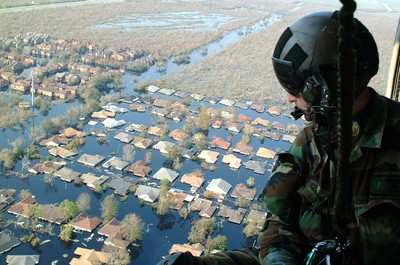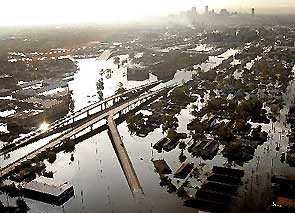But It Ain't Easy Being A PJ
To Hurricane Katrina victims pararescuemen were angels. To
injured airmen they're saviors.

Known as "PJs," these airmenare part of an elite team specially
trained in combat recovery and rescue. For 16 PJs with the 58th
Rescue Squadron here, the military training they have paid off when
they plucked civilians and pets off rooftops after Hurricane
Katrina.
"We picked up a lot of old ladies, and they told us we were like
angels from the sky," said PJ Staff Sgt. Mike Maroney. "Then they
gave us a hug and a kiss."
In all, Sergeant Maroney estimates he helped rescue more than
160 people after Katrina. His supervisor, Master Sgt. Greggory
Plasch the Katrina experience is one he won't soon forget.
"Being in my own country and rescuing American citizens had a
big impact on me," the operations sergeant said. "We're set up for
combat rescue. That means the people we pick up are usually
(injured but otherwise) healthy people. But with Katrina, it ran
the whole gamut -- from infants to elderly. That part was pretty
intense."
In some cases the PJs went down for a rescue, but the people
wouldn't leave because they didn't want to leave pets behind.
"Some stranded people said the only way they would come with us
is if we took their dogs -- and they were big dogs," Sergeant
Plasch said. "We put the first dog in a backpack and hoisted him
up."

After sending the two women up to safety, the sergeant had to go
up with another dog, which clung to him. All made it safety.
"The funniest part of the whole situation was when we were all
safe in the helicopter -- the woman said she forgot to lock her
door," she said.
Tech. Sgt. Keith O'Grady, said he has never seen the kind of
devastation Katrina and Rita caused.
"I was deployed to both of the hurricane recovery missions," the
PJ said. "It felt good helping Americans -- our own people."
Sergeant O'Grady said many people "didn't realize how bad the
devastation was until they were hoisted up into the helicopter.
Almost everyone I rescued burst into tears."
Being able to rescue people requires years of training and
dedication. For the 250 active-duty airmenworldwide who aid in
combat recovery and rescue, it all starts at technical school.
Senior Airman Brad Woodward said going through the PJ pipeline
is not easy.
"The pipeline consists of (eight) schools a PJ must complete and
pass before he is awarded his beret," Airman Woodward said. "From
beginning to end, going through the pipeline can take anywhere from
18 months to two years."
The schools are pararescue and combat control indoctrination;
scuba, paramedic and airborne; survival, evasion, resistant, and
escape; underwater egress; freefall and apprentice.
The first -- and probably the hardest course -- is the
indoctrination course, according to Airman Woodward. This course
determines whether airmenwill make it as a PJ. The drop-out rate
can be as high as 85 percent. The 10-week course consists of
running, calisthenics, swimming, water confidence events,
open-water compass swims, obstacle course, weight training, weapons
qualification, motivational week, CPR, altitude chamber, pipeline
briefings and academics.

"I think everybody would attest to the indoctrination courses in
the pipeline as being the most demanding," Airman Woodward said.
"This is where they weed out the weak. This is probably the most
mentally and physically challenging course because you are put in
very uncomfortable situations."
He said, "You might go through exercises where your air is taken
away from you. It's exciting to go through the training, and it's
necessary for the job because when you are put in real-life
scenarios you can't afford for someone to quit or give up when they
are trying to rescue someone."
Second Lt. Jason Egger, officer in charge of the squadron, said
the unit's primary mission is combat search and rescue and
personnel recovery. But the unit trains for the whole spectrum of
personnel recovery. That's where the survival evasion resistant
escape element comes in with combat rescue officers and the
pararescuemen.
"Our weapon system is called 'The Guardian Angel,'" Lieutenant
Egger said. "There are three career fields in the weapon system."
They include SERE (survival, evasion, resistant, and escape),
pararescuemen and combat rescue officer.
"There are five phases of a recovery mission -- report, locate,
support, recover and reintegrate. CROs are responsible for phase
four recovery," Lieutenant Egger said. "SERE takes care of phases
one, two, three and five, whereas the CRO participates in all five
of the phases."
For Airman David Schumacher, a squadron SERE specialist, it took
awhile to realize he wanted to become a pararescuemen.
"I planned to get out of the Air Force after I received my
degree," he said. "But I decided I wanted to become a PJ."
He knows he's in for a long haul, and he is training daily to
prepare himself for the hardest part of the pipeline: in February
he goes to the indoctrination course.

The PJs were a welcome site to the people who survived Katrina
and Rita. Many owe their lives to the world-class training these
airmen receive.
Lieutenant Egger makes no bones about it -- he said his unit is
the best-trained recovery force in the world.
"I am lucky to be here and work with these guys," the lieutenant
said. "I wouldn't trade this job for anything."
 ANN's Daily Aero-Term (04.14.24): Maximum Authorized Altitude
ANN's Daily Aero-Term (04.14.24): Maximum Authorized Altitude ANN's Daily Aero-Linx (04.14.24)
ANN's Daily Aero-Linx (04.14.24) Classic Aero-TV: 'We're Surviving'-- Kyle Franklin Describes Airshow Life 2013
Classic Aero-TV: 'We're Surviving'-- Kyle Franklin Describes Airshow Life 2013 Aero-News: Quote of the Day (04.14.24)
Aero-News: Quote of the Day (04.14.24) Airborne 04.09.24: SnF24!, Piper-DeltaHawk!, Fisher Update, Junkers
Airborne 04.09.24: SnF24!, Piper-DeltaHawk!, Fisher Update, Junkers






